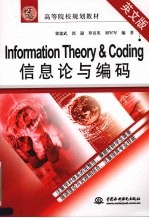
- 作 者:梁建武,郭迎,罗喜英等编著
- 出 版 社:北京:中国水利水电出版社
- 出版年份:2008
- ISBN:9787508455693
- 标注页数:197 页
- PDF页数:209 页
请阅读订购服务说明与试读!
订购服务说明
1、本站所有的书默认都是PDF格式,该格式图书只能阅读和打印,不能再次编辑。
2、除分上下册或者多册的情况下,一般PDF页数一定要大于标注页数才建议下单购买。【本资源209 ≥197页】
图书下载及付费说明
1、所有的电子图书为PDF格式,支持电脑、手机、平板等各类电子设备阅读;可以任意拷贝文件到不同的阅读设备里进行阅读。
2、电子图书在提交订单后一般半小时内处理完成,最晚48小时内处理完成。(非工作日购买会延迟)
3、所有的电子图书都是原书直接扫描方式制作而成。
Chapter 1 Introduction 1
Contents 1
Before it starts,there is something must be known 1
1.1 What is Information 2
1.2 What's Information Theory? 4
1.2.1 Origin and Development of Information Theory 4
1.2.2 The application and achievement of Information Theory methods 6
1.3 Formation and Development of Information Theory 7
Questions and Exercises 8
Biography of Claude Elwood Shannon 8
Chapter 2 Basic Concepts of Information Theory 11
Contents 11
Preparation knowledge 11
2.1 Self-information and conditional self-information 12
2.1.1 Self-Information 12
2.1.2 Conditional Self-Information 14
2.2 Mutual information and conditional mutual information 14
2.3 Source entropy 16
2.3.1 Introduction of entropy 16
2.3.2 Mathematics description of source entropy 17
2.3.3 Conditional entropy 20
2.3.4 Union entropy(Communal entropy) 20
2.3.5 Basic nature and theorem of source entropy 21
2.4 Average mutual information 26
2.4.1 Definition 26
2.4.2 Physics significance of average mutual information 27
2.4.3 Properties of average mutual information 28
2.5 Continuous source 38
2.5.1 Entropy of the continuous source(also called differential entropy) 39
2.5.2 Mutual information of the continuous random variable 44
Questions and Exercises 44
Additional reading materials 46
Chapter 3 Discrete Source Information 51
Contents 51
3.1 Mathematical model and classification of the source 51
3.2 The discrete source without memory 54
3.3 Multi-marks discrete steady source 60
3.4 Source entropy of discrete steady source and limit entropy 67
3.5 The source redundancy and the information difference 71
3.6 Markov information source 71
Exercise 77
Chapter 4 Channel and Channel Capacity 79
Contents 79
4.1 The model and classification of the channel 79
4.1.1 Channel Models 79
4.1.2 Channel classifications 80
4.2 Channel doubt degree and average mutual information 82
4.2.1 Channel doubt degree 82
4.2.2 Average mutual information 82
4.2.3 Properties of mutual information function 83
4.2.4 Relationship between entropy,channel doubt degree and mutual information 86
4.3 The discrete channel without memory and its channel capacity 88
4.4 Channel capacity 89
4.4.1 Concept of channel capacity 89
4.4.2 Discrete channel without memory and its channel capacity 91
4.4.3 Continuous channel and its channel capacity 99
Chapter 5 Lossless source coding 106
Contents 106
5.1 Lossless coder 106
5.2 Lossless source coding 110
5.2.1 Fixed length coding theorem 110
5.2.2 Unfixed length source coding 113
5.3 Lossless source coding theorems 115
5.3.1 Classification of code and main coding method 115
5.3.2 Kraft theorem 116
5.3.3 Lossless unfixed source coding theorem(Shannon First theorem) 116
5.4 Pragmatic examples of lossless source coding 120
5.4.1 Huffman coding 120
5.4.2 Shannon coding and Fano coding 128
5.5 The Lempel-ziv algorithm 130
5.6 Run-Length Encoding and the PCX format 132
Questions and Exercises 134
Chapter 6 Limited distortion source coding 137
Contents 137
6.1 The start point of limit distortion theory 138
6.2 Distortion measurement 140
6.2.1 Distortion function 140
6.2.2 Average distortion 142
6.3 Information rate distortion function 143
6.4 Property of R(D) 145
6.4.1 Minimum of D and R(D) 145
6.4.2 Dmax and R(Dmax) 151
6.4.3 The under convex function of R(D) 154
6.4.4 The decreasing function of R(D) 154
6.4.5 R(D)is a continuous function of D 155
6.5 Calculation of R(D) 156
6.5.1 Calculation of R(D)of binary symmetric source 156
6.5.2 Calculation of R(D)of Gauss source 158
6.6 Limited distortion source encoding theorem 159
Additional material for this chapter 161
Questions and exercises 168
Chapter 7 Channel Coding Theory 170
Contents 170
7.1 Channel coding theorem for noisy channel 170
7.2 Introduction:the generator and parity-check matrices 174
7.3 Syndrome decoding on q-ary symmetric channels 177
7.4 Hamming geometry and code performance 179
7.5 Hamming codes 180
7.6 Cyclic code 181
7.7 Syndrome decoding on general q-ary channels 191
Questions and exercises 194
Bibliography 197
